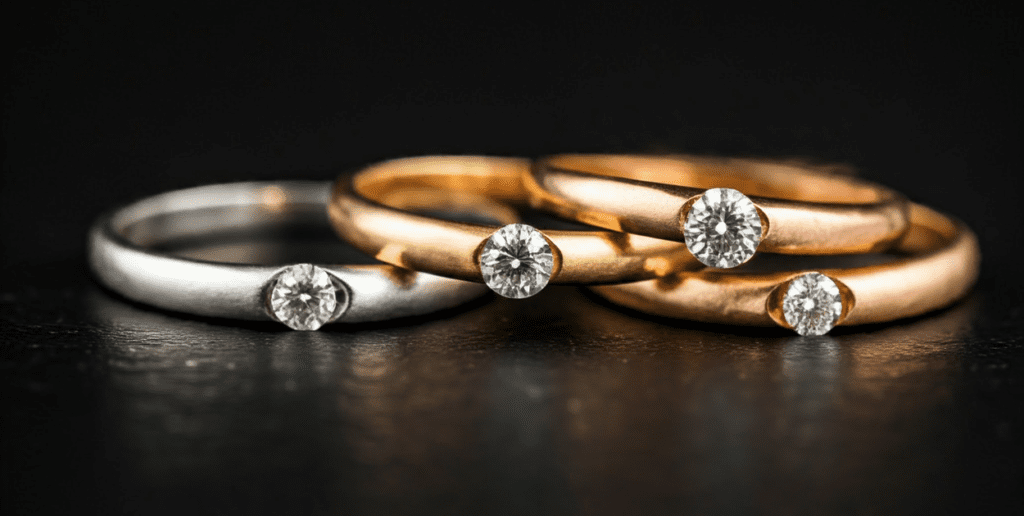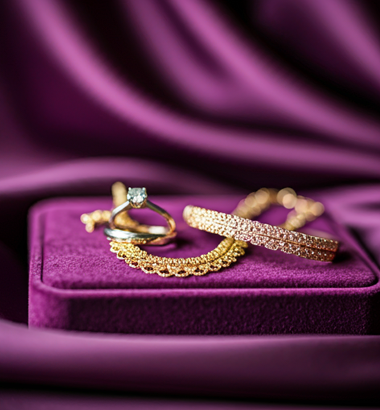When it comes to choosing gold for jewelry or investment, it’s essential to understand the differences between the various types: white gold, yellow gold, and rose gold. Each type has its own unique characteristics, from color to composition, and these factors can influence your choice depending on your personal style, budget, and the occasion. In this blog, we’ll explore the key differences between white, yellow, and rose gold and help you determine which one is the perfect fit for you.
Color, Composition, and Cost
The primary difference
 between white, yellow, and rose gold is their color, which is achieved by mixing pure gold with different metal alloys. Pure gold is naturally yellow and is too soft for making durable jewelry, so it is alloyed with other metals to increase its strength and modify its appearance.
between white, yellow, and rose gold is their color, which is achieved by mixing pure gold with different metal alloys. Pure gold is naturally yellow and is too soft for making durable jewelry, so it is alloyed with other metals to increase its strength and modify its appearance.- Yellow Gold:
- Color: Yellow gold has a warm, traditional hue that is closest to the natural color of pure gold.
- Composition: Yellow gold is usually mixed with metals like copper and silver to maintain its warm tone while adding durability. The higher the karat, the more gold content in the alloy, making it softer and more malleable.
- Cost: Generally, yellow gold is slightly more affordable than white gold because it does not require rhodium plating. However, the price still varies based on the karat and purity.
- White Gold:
- Color: White gold has a sleek, silvery-white appearance, achieved by mixing pure gold with metals like palladium, nickel, or manganese.
- Composition: White gold is often coated with a thin layer of rhodium, a platinum-like metal, to give it a bright, reflective finish. This coating can wear over time and may require re-plating.
- Cost: White gold tends to be a bit more expensive than yellow gold due to the rhodium plating process and the metals used in its alloy. However, it is usually less expensive than platinum, making it a popular alternative for engagement rings and wedding bands.
- Rose Gold:
- Color: Rose gold has a distinct pinkish-red hue, giving it a romantic and vintage feel.
- Composition: The blush tone of rose gold comes from a higher percentage of copper in the alloy, mixed with gold and sometimes silver. The more copper in the mix, the stronger the pink tint.
- Yellow Gold:
Cost: Rose gold is generally priced similarly to yellow gold, though the amount of copper in the alloy can affect the price. It’s typically less expensive than white gold due to the absence of rhodium plating.
Popular Uses for Each Type of Gold
 Each shade of gold is associated with different trends and uses, making some types more suitable for certain occasions or styles.
Each shade of gold is associated with different trends and uses, making some types more suitable for certain occasions or styles.- Yellow Gold:
- Popular Uses: Yellow gold is often seen in classic and vintage jewelry designs, making it a popular choice for traditional engagement rings, wedding bands, and heirloom pieces. Its timeless appeal and warm hue make it ideal for those who appreciate a more traditional aesthetic.
- Styling: Yellow gold pairs well with warmer skin tones and works beautifully with diamonds, emeralds, and other richly colored gemstones.
- White Gold:
- Popular Uses: White gold is commonly used in modern and minimalist jewelry designs, as well as engagement rings and wedding bands. Its sleek, silver-like appearance gives it a contemporary edge, making it perfect for those who prefer a more modern and understated look.
- Styling: White gold complements cool skin tones and is an excellent choice for diamonds and other colorless gemstones. It’s often favored for settings where a bright, clean contrast to the gemstone is desired.
- Rose Gold:
- Popular Uses: Rose gold is frequently seen in fashion-forward, vintage, and romantic jewelry styles. It has gained popularity in engagement rings, bracelets, and necklaces thanks to its unique and delicate pink hue.
- Styling: Rose gold flatters most skin tones due to its warm, reddish-pink tint and is often paired with diamonds, morganites, and other softer-toned gemstones. Its romantic appeal makes it a popular choice for couples looking for something less traditional.
- Yellow Gold:
Conclusion
Whether you prefer the classic charm of yellow gold, the sleek sophistication of white gold, or the romantic allure of rose gold, each type of gold has something special to offer. When choosing the right gold for your jewelry, consider your personal style, skin tone, and the occasion.
At our store, we offer a wide range of yellow, white, and rose gold pieces to suit every preference and budget. From engagement rings to statement necklaces, our expert team is here to help you find the perfect gold item that matches your taste and style. Visit us today to explore our collection and discover the timeless beauty of gold.

 between white, yellow, and rose gold is their color, which is achieved by mixing pure gold with different metal alloys. Pure gold is naturally yellow and is too soft for making durable jewelry, so it is alloyed with other metals to increase its strength and modify its appearance.
between white, yellow, and rose gold is their color, which is achieved by mixing pure gold with different metal alloys. Pure gold is naturally yellow and is too soft for making durable jewelry, so it is alloyed with other metals to increase its strength and modify its appearance. Each shade of gold is associated with different trends and uses, making some types more suitable for certain occasions or styles.
Each shade of gold is associated with different trends and uses, making some types more suitable for certain occasions or styles.